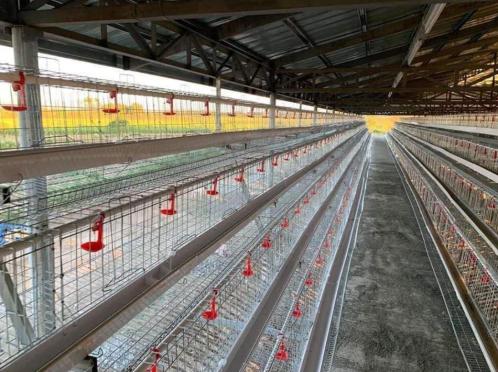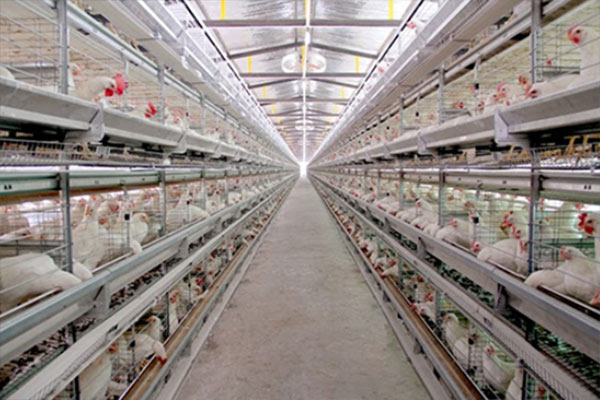In modern poultry farming, the design and management of chicken cages are crucial. A well-designed chicken cage can enhance the quality of life for hens and significantly boost farming efficiency. This article explores the best practices for designing and managing chicken cages to achieve optimal production outcomes and ensure the well-being of the birds.
Key Elements of Chicken Cage Design
- Space LayoutThe design of chicken cages must carefully consider the space requirements of hens. Overcrowded cages can lead to stress, increased disease risk, and lower egg production. According to standards, each hen should have approximately 450 to 600 square centimeters of space in a layer cage. This not only improves comfort but also boosts egg production rates.
- Ventilation SystemAn effective ventilation system is essential for maintaining air quality inside chicken cages. The cage design should include sufficient ventilation holes or fans to prevent the accumulation of ammonia and other harmful gases. Proper airflow also helps regulate temperature and humidity, preventing health issues caused by overheating or damp conditions.
- Lighting ConditionsLighting significantly impacts hens’ production performance. The design of chicken cages should incorporate artificial lighting systems to simulate natural light cycles, promoting a healthy biological rhythm and enhancing egg production. It is recommended to provide 14 to 16 hours of light per day to support hens’ health and productivity.
- Feeding and Drinking SystemsEfficient feeding and drinking systems are crucial elements of chicken cage design. Automated feeding and watering systems can reduce labor intensity and ensure that each hen receives adequate nutrition and hydration. Consideration should be given to the system’s maintenance needs and durability to minimize downtime and repair costs.

Best Practices for Chicken Cage Management
- Hygiene Management:
Keeping chicken cages clean is vital for disease prevention and ensuring hens’ health. Regularly remove droppings and debris from the cages and use appropriate disinfectants for cleaning. The frequency of cleaning should be adjusted based on the cage’s usage and the number of hens. Good hygiene management also helps reduce pest and pathogen populations. - Disease Prevention:
Disease prevention is a key aspect of cage management. Regularly check the health of the hens and watch for any abnormal symptoms. Use vaccines and medications to prevent common diseases, and maintain a dry and well-ventilated environment to reduce disease spread. - Routine Inspection and Maintenance:
Regularly inspect the structure and facilities of chicken cages to ensure they are functioning properly. Check for damage to the cage mesh, the operation of automatic feeding and watering systems, and the effectiveness of ventilation systems. Timely repairs and replacements of damaged components are essential to keep the cages in optimal condition. - Behavioral Observation:
Observing hens’ behavior can help identify potential issues, such as overcrowding, pecking, or loss of appetite. By monitoring daily activities, adjustments can be made to the cage design and management practices to improve the living conditions and production performance of the hens.

Common Challenges and Solutions in Cage Design and Management
- Space Constraints:
When designing chicken cages in limited spaces, optimizing space usage is essential. Consider multi-tier designs to increase vertical space, providing sufficient living space for each hen. Avoid overcrowding to ensure each hen can move freely. - High Temperature and Humidity:
In environments with high temperatures and humidity, temperature and humidity control in chicken cages is crucial. Use cooling systems and dehumidifiers to maintain suitable environmental conditions. Regularly check and maintain these systems to ensure their effective operation. - Automation System Failures:
Failures in automated feeding and watering systems can affect hens’ health. Choose reliable automation equipment during the design phase and establish backup systems for emergencies. Regular maintenance and inspection of equipment can help reduce failure rates.
Future Trends
As technology advances, chicken cage design and management are continuously evolving. The application of smart technologies, such as data monitoring systems and environmental control systems, will further enhance cage management efficiency and production effectiveness. Future designs will place greater emphasis on hen welfare and environmental sustainability.
Conclusion
The design and management of chicken cages are critical components of modern poultry farming. By implementing sound design principles and effective management practices, farmers can improve hens’ quality of life, reduce disease risks, and maximize farming efficiency. Staying informed about industry trends and technological advancements will help farmers achieve more efficient and sustainable production models.